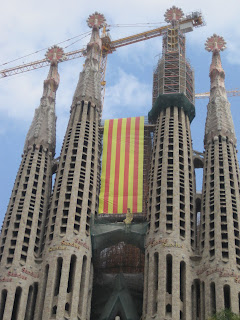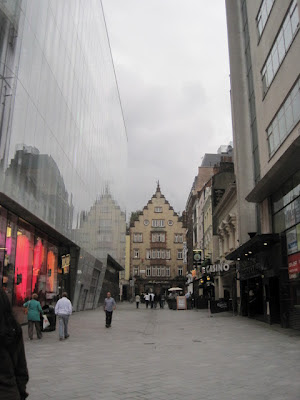I had the great fortune to spend one week this July in London with Rana and O. I will tell you right now, one week is barely enough to see the majority of the city, and you would need far more to see anything outside of the main downtown area, even if you can handle doing touristy things for sixteen hours a day. (One must sleep, afterall)
After having visited cities in the Northern and central regions of Spain, two Italian cities, and much of South Western France, I thought I had tired of seeing European architecture. The second I stepped out of the train station I realized I was wrong. It was a refreshing and beautiful change from Mediterranean buildings to British structures. The overall feel of the city was cheery and uplifting, as compared to the calm and serious soberness of Paris, or the exciting and tense sensation one feels in Barcelona. Suddenly I felt the need to smile, say 'cheerio' and go about my business with a spring in my step.
We stayed in a loft style flat above some shops in a peaceful London outskirt neighborhood. Our hosts were a couple from France and Sweden, who now work in London. The directions we were given to find the place included looking for this bread shop called 'bread shop.' We arrived in the evening, and so finished our first day by eating dinner at a local pub.
The second day we went to see some of the major sights. First stop: Buckinghum Palace and the Changing of the Guards.
The palace is a sight to see, and has a beautiful park and pond near by. When we arrived they were in the process of setting up for the Olympic games, so much of the park was covered with temporary barriers.
The changing of the guards is as much worth seeing as all of the hype will lead you to believe. My advice: GET THERE EARLY. During the summer they do it twice daily. But there will be a big crowd, especially if it is a nice day, of tourists wanting to get a good shot. The hats on the guards will make you grin!
Here is a guard in a guard house outside the palace.
It is not a trip to London without seeing a red telephone booth and riding in the top of a double decker bus. Afterwards, go to a pub for some beer, or a cup of tea.

All of the museums owned by the city are free to the public with a suggested donation of three or four British Pounds. This includes the natural history museum, many art galleries, among other things. Like many large tourist attraction type cities, London offers a "tourist pass" that enables you to get into almost every attraction in the city for free or at a discount. The London Pass can be purchased for a one day use up to a full week's use. With it you will receive discounts at certain retailers, free or lowered entry to Prince Albert Royal Hall, boat rides through the canals, and even entry into the London Tower (which is where you get to see the crown jewels and the military museum). If you so choose to spend more than a day or two in London (which isn't even enough time to see all of the free museums), you should consider getting a London Pass.

Big Ben is of course the symbol of London that most of us Staters think of when the city is mentioned to us. It is a towering and beautiful figure, and like most monuments, draws a great crowd.
There are two major "cathedrals" to see in London. Westminster Abbey (pictured here) and St. Paul's Cathedral are both worth your time. Whether you are of great faith, little faith, or no faith, they are beautiful buildings, with inspiring stories and traditions. Westminster is known for having held Princess Diana's funeral, the Queen's inauguration, among other important events in the royal family. St. Paul's is celebrated as being open to all faiths for worship, and to all people for events of the world. In the aftermath of world devastation, such as the 9/11 event in the US or the Tsunami in Japan, the Cathedral holds public prayer and grief sessions, especially to help visitors to the city who are from the location hit by the tragedy. If you go, be sure to check out the crypt.

We got a chance to checkout the Churchill War Rooms, which is an interesting museum, set up in the actual location of the War Rooms. There are displays set up to demonstrate daily life during those days, and maps from actual events and strategies. I'm a lover of maps, so this was a real treat to see.
It is not a trip to another country if you don't try the local cuisine! British pastries are a delicious way to start the morning. Chances are, if you're staying in an apartment at the edge of the city, there is a bakery right down the street from you, filled with all kinds of crumpets and scones just waiting for your teeth to sink into them. Don't forget to order a pot of tea to go with them.

Of all of the European cities I have traveled in, London is by far the most child friendly. Their museums, with the exception of Church's and Art museums, have interactive activities that engage and excite the young and the young at heart. When we visited Kensington Palace, and spent time in the party rooms, there was a card game you could play as you went along. Each card had a fact about etiquette of the court during earlier centuries. There were also places where children could sit and draw, and in a room that showed toys from the childhoods of past rulers, there were replicas out in the open to be touched and handled by all.
This beautiful block caught my eye in the Drawing Room. I am a lover of time keepers, and with a map on it, it was a wonderful site to see.
As we exited Kensington Palace, we were greeted with the site of classically dressed dancers (as well as tourists who were classically dressed in jeans and t-shirts) performing line dances. There was much going on in the city as a celebration of the Queen's Diamond Jubilee, and this was one of the events. If we had arrived closer to the beginning of the dance, I surely would have joined in.

The structure above is a monument that was erected for Prince Albert after his death. It was a part of an enormous project made in the late Prince's honor. Situated at the far end of Hyde park (opposite of Kensington Palace). The money that had been earmarked to build the Prince Albert Royal Hall was used instead on this monument. The Hall had to raise funds by selling seats with one hundred year contracts for families. To this day the royal family holds a private box in the grand theater. We enjoyed a tour of the Hall, but photography was not allowed inside. It is known to have played host to many performers and incredible performances, and is well worth a visit if you've got a chance.
The Natural History Museum is among the many places open to the public and free to enter. There are many beautiful fossils preserved here for all eyes to see. At the time of their discovery, these dinosaur bones were thought to be some form of alligator.
In the museum is this beautiful collection of hummingbirds, possibly hundreds of different kinds.
There are several markets in London, all of which are worth a visit if you have the time. Camden Town (pictured here) is full of shops that celebrate all kinds of fashion styles. As one of the European fashion capitols (like Paris, Rome, and Barcelona) London sports its own twist on modern fashion. Portobello Road Market is an exciting place to visit if you're looking for a unique clock or other decoration, or just enjoy browsing through antiques and indie fashion.
We enjoyed an afternoon at the zoo, watched some animal shows, and said hello to many friendly creatures.
The London Zoo has a beautiful butterfly exhibit right now, which includes some gorgeous nocturnal moths. O demonstrated the size of this beautiful creature with his hand.
England has one of the largest collections of international relics in the world. There are pieces from Ancient Egypt, Greece, and the Middle East, as well as from all over Western Europe and all across Asia.
This Roman imitation of a Greek statue shows the eternal interest of one culture in another. Centuries later, England found themselves imitating Roman culture, Egyptian culture, and so on. Today, many Western youths try to imitate Japanese and other Asian cultures in their decoration, fashion, and diet, while many Eastern youths do the same with Western culture. It goes to show that in human nature we always want what we do not have.
There are two types of vehicle you are bound to notice in London. The double decker bus and the taxi cab. Another important and often confusing thing to note, they do indeed drive on the opposite side of the road in England. It is my advice that you use public transit and walk rather than drive a car yourself if you are used to the more international road direction of the right hand side.
This little restaurant in the China Town area of London had me concerned. Are those the kind of people they serve, or the food they serve to the people? Either way, I'm not sure it is somewhere I'd like to dine.
But joking aside, if you're into different cuisines, and you tire of fish and chips, China Town London is a great places to look for and have a hot meal. The prices tend to be more reasonable than other parts of town, and the selection is vast. There are other culturally focused neighborhoods in the city, all of which have wonderful restaurants for your tasting pleasure.
We enjoyed a meal at Mr. Kong's restaurant when we visited China Town. Often times these kind of restaurants will have a suggested tourist meal for multiple people. It tends to be of high value and have all of the most popular dishes included, and will save you time if you don't want to go through the whole menu. This particular restaurant was full of locals, including business men and what appeared to be a couple celebrating an anniversary.
Again, I was very happy to be seeing a different sort of architecture.
I adore the Tudor style buildings. Much like Basque architecture, it is a beautifully contrasted style, with the dark lines and white walls.
We took a boat tour through Little Venice, a set of canals that run through the city.
Canals were made throughout England as a means of transport, by boat. The boats were tugged along by a single horse, and were home and office to merchant families. Today most of the boats are stationary and serve as permanent dwellings for many English citizens.
London is a wonderful place to visit, I especially encourage people with children who would like a European experience to visit this friendly city. There are many more things I'd like to talk about, and will do so in a later post.
Enjoy your summers, my dear readers.


























































